
About UsThe Numismatic Bibliomania Society is a non-profit organization promoting numismatic literature. For more information please see our web site at coinbooks.org SubscriptionsThose wishing to become new E-Sylum subscribers (or wishing to Unsubscribe) can go to the following web page link MembershipThere is a membership application available on the web site Membership Application To join, print the application and return it with your check to the address printed on the application. Membership is only $15 to addresses in the U.S., $20 for First Class mail, and $25 elsewhere. For those without web access, write to: David M. Sundman, Secretary/TreasurerNumismatic Bibliomania
Society AsylumFor Asylum mailing address changes and other membership questions, contact David at this email address: dsundman@LittletonCoin.com SubmissionsTo submit items for publication in The E-Sylum, just Reply to this message, or write to the Editor at this address: whomren@coinlibrary.com
BUY THE BOOK BEFORE THE COINYou won't regret it! |
- WAYNE'S WORDS: THE E-SYLUM APRIL 1, 2012
- THE E-SYLUM : HOW MANY ISSUES?
- MORE ON NBS COFOUNDER JACK COLLINS
- STEPHEN L. PELLEGRINI
- URUGUAYAN NUMISMATIC PUBLICATION EL SITIO NO. 2 AVAILABLE
- ANA TO NAME NEW EXECUTIVE DIRECTOR
- ANA NUMISMATIC THEATRE LINEUP FOR 2012 DENVER SHOW
- THE PROPOSED U.S MINT AT THE DALLES, OREGON
- QUIZ ANSWER: THE HARTE-TWAIN NUMISMATIC CONNECTION
- 19TH CENTURY U.S. PORTRAIT IDENTIFICATIONS PROPOSED
- MORE ON THE SPANGENBERGER 1876 CENTENNIAL COLLECTION
- NOTES FROM E-SYLUM READERS: APRIL 1, 2012
- QUERY: CAMBODIAN COIN AUCTION CITATIONS SOUGHT
- QUERY: PORTRAIT VIGNETTES SOUGHT FOR FRACTIONAL CURRENCY BOOK
- QUERY: SCHULMAN MEDALLIC HISTORY OF MONEY AND BANKING
- QUERY: LINCOLN MEDAL ORIGIN SOUGHT
- EXHIBIT: THE NEW MEDALLISTS
- FRELINGHUYSEN STAMP COLLECTION BRINGS RARITIES TO MARKET
- FERN BAR FOUNDER'S ORIGINAL TIFFANY LAMPS BEING SOLD
- ARTICLE HIGHLIGHTS PHOENIX "PHX BUX" COINS
- CANADA TO ELIMINATE THE CENT
- DICK JOHNSON: CANADA ABOLISHES CENT
- A REVIVED EAST INDIA COMPANY STRIKES COINS
- FAMILY HOLDS RECORD FOR VICTORIA CROSS AWARDS
- FEATURED WEB SITE: THE BRITISH ART MEDAL SOCIETY
WAYNE'S WORDS: THE E-SYLUM APRIL 1, 2012

New subscribers this week include Peter Burnside. Welcome aboard! We have 1,525 email subscribers, plus 174 followers on Facebook.
This week we open with some statistics on The E-Sylum, some background on NBS cofounder Jack Collins, and belated word of the passing of an E-Sylum subscriber and contributor.
Other topics include: CANADA ABOLISHES CENT, the proposed U.S. Mint at The Dalles, OR, portrait vignettes, Cambodian coins at auction, and Schulman's Medallic History of Money and Banking.
To learn more about new varieties of Uruguayan coins and banknotes, the new ANA Executive Director, a medal exhibit at the Victoria and Albert museum, "Phx Bux" coins and paranormal coins and currency, read on. Don't worry, be happy! Have a great week, everyone!
Wayne Homren
(whomren@gmail.com)
Numismatic Bibliomania Society
THE E-SYLUM : HOW MANY ISSUES?
Bob Julian writes:
Why not also list (in addition to volume and number) the cumulative number of issues of The E-Sylum? It has to be a rather impressive number by now.
Good idea! Bob's note prompted me to run some numbers. From our inception on September 4, 1998 through last week (March 25, 2012) there have been a total of 712 issues. This includes a few special issues sent midweek with time-sensitive information. But for the most part we've published on a regular weekly basis for going on fourteen years. Early issues had just a handful of articles but this measure grew over time to an average of twenty.
Our total article count to date is a whopping 14,374, all archived on the NBS web site. This should make clear what I've often said over the years - we're not just publishing a weekly newsletter, we're building a web site. It should now also be clear why I make it a point to quote extensive passages from other web sites and store copies of all the images in our own archive - web content often moves or vanishes over time, but our E-Sylum archive has remained intact. Links may grow stale, but the content we published ourselves has been preserved.
None of this could have happened so smoothly without the support of our webmaster Bruce Perdue and John Nebel, who has provided web site hosting gratis for NBS since our web site's inception. Not only that, John did the computer programming required to automate the population of the E-Sylum archive - every Sunday night Bruce uploads the complete E-Sylum issue to the site, and in the wee hours of the morning John's scripts kick in and split the issue into individual article pages, update the tables of contents and create our RSS feed, like obedient little robots.
And I would be remiss not to thank NBS for their funding in late 2007 to pay for web designers and developers who helped spiff up the site and even more importantly, allowed us to make the leap from plain text to HTML in the weekly newsletter - that was like stepping into the Technicolor Land of Oz from the dreary black-and-white past.
If you haven't visited our archive lately, check it out. Bruce and John have already implemented the changes Bob suggested. And thus ends another article. Thanks for sticking with us!
To access the E-Sylum archive, see: www.coinbooks.org/club_nbs_esylum_archive.html
To read the complete E-Sylum Table of Contents, see: www.coinbooks.org/esylum_toc.html

MORE ON NBS COFOUNDER JACK COLLINS
In his obituary of Jack Collins in The Asylum, George Kolbe summed Collins up well when he wrote that whereas some people march to the beat of a different drummer, Collins marched to the beat of a different orchestra. Collins's real name was Charles Meredith Brainard, and he was born in 1939 in Detroit. You will find confirmation of this detail at this link to the 1990 update of the genealogy of the Brainard family: archive.org/stream/1990updatetogene01brai/1990updatetogene01brai_djvu.txt
This can also be confirmed by looking at ANA member directories from the early 1960s, where Charles M. Brainard is listed at the same address in South Gate that Jack Collins is known to have lived at later on. Brainard/Collins was no relation, so far as I know, to Karl M. Brainard, who founded the Numismatic Association of Southern California.
Collins continued to live at the same address in South Gate in Los Angeles County, and his mother, who retained the name Brainard, lived there as well, so the change of identity was somewhat transparent - Collins was no Reggie Perrin (to say nothing of John Stonehouse or John and Anne Darwin).
He was a brilliant photographer - his black and white photographs have a unique look - he lit the coins with a very intense light that makes it easy to see the dies and die states. His photographs are in the Breen half-cent and cent books.
My own experience with Collins was quite positive. I never met him in person, but I once had a good conversation with him on the telephone. He was very helpful to the American Numismatic Society in its search for the large cents that had been stolen by Dr. Sheldon.
To read the earlier E-Sylum article, see: ALAN WEINBERG RECALLS JACK COLLINS (www.coinbooks.org/esylum_v15n13a05.html)
STEPHEN L. PELLEGRINI
Henry Scott Goodman writes:
I was recently contacted by the Pellegrini family after they found my name in Steve's Rolodex. The family informed me that Steve had passed away last September due to complications from diabetes. I knew Steve was battling the disease when he suddenly disappeared last summer. I had no way of locating him.
Although Steve was rather enigmatic and reclusive, I was still able to strike up a limited friendship with him due to our common interests in WWI and Goetz medals. He wrote well about many subjects related to WWI propaganda and art medal and medallion production. He was passionate about medal collecting and loved the history perhaps more than the medals.
I will miss Steve and the loss of future opportunities to bounce questions off him and walking away with an education.
URUGUAYAN NUMISMATIC PUBLICATION EL SITIO NO. 2 AVAILABLE
Horacio Morero of Montevideo, Uruguay writes:
Here are some highlights of our second publication: El Sitio Nº 2.
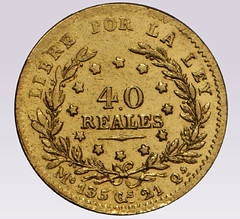 * In the cover, the picture of a beautiful and scarce gold essay: 40 Reales 1854 minted in Montevideo mint. This coin was recently auctioned by Stack's Bowers at $ 44,250.
* In the cover, the picture of a beautiful and scarce gold essay: 40 Reales 1854 minted in Montevideo mint. This coin was recently auctioned by Stack's Bowers at $ 44,250.
* Editorial: you can read the acknowledgments in relation to the El Sitio Nº 1; you can find the E-Sylum mention. Thanks again !!!
* Articles:
a) Home Savings Boxes of the Caja Obrera Bank.
b) New varieties found in Uruguayan coins and banknotes.
c) The albums of the National Bank of Republic of Uruguay.
d) Exhibition of Uruguayan basketball medals.
e) Socials: end of year farewell.
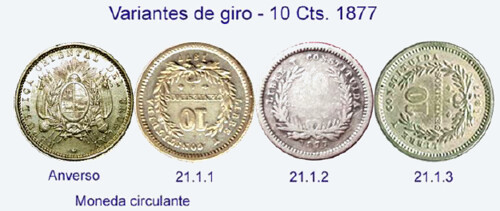
To read the earlier E-Sylum article, see: NEW PERIODICAL: EL SITIO (www.coinbooks.org/esylum_v15n01a06.html)
THE BOOK BAZARRE
ANA TO NAME NEW EXECUTIVE DIRECTOR
Fully aware of the importance of their choice to the future of this national institution, the search committee placed a high bar for applicants. First, no lawyers. And yes, ANA counsel Ron Serna has been a good sport throughout the process, stating "I didn't really want the stupid job anyway."
Other important qualifications were, in no particular order, an understanding of high finance, experience running large organizations, a demonstrated fair-to-middling knowledge of numismatics, good teeth, and no impending lawsuits.
Our new Executive Director got his start in numismatics trading ancient coins at Numismatic Fine Arts, later expanding into antiquities under the steady tutelage of Robert Hecht, Jr. His financial dealings led him to the film and sport industries, where he produced movies and bought a professional hockey team. His name? Bruce MacNall.
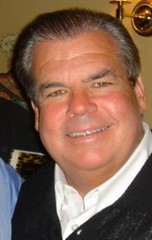 However, in the early 1990s, he came under suspicion of defrauding banks out of more than $200 million. He eventually pleaded guilty and in 1997, began serving a 70-month sentence in federal prison. But that sentence was later reduced by 13 months for good behavior (and nice teeth). He was released in 2001.
However, in the early 1990s, he came under suspicion of defrauding banks out of more than $200 million. He eventually pleaded guilty and in 1997, began serving a 70-month sentence in federal prison. But that sentence was later reduced by 13 months for good behavior (and nice teeth). He was released in 2001.
The search committee was quite confident in their choice, stating "Lightning never strikes twice, right? What are the odds he'll end up back in prison this time?"
"I haven't felt stigmatized by my past yet," said MacNall. "Oddly enough, people have welcomed me, which maybe has to do with my great failing. I always tried to make everybody happy."
For more information on the American Numismatic Association, see: www.money.org
ANA NUMISMATIC THEATRE LINEUP FOR 2012 DENVER SHOW
 The American Numismatic Association has announced the Numismatic Theatre schedule for the 2012 Spring National Money Show, May 10-12 at the Colorado Convention Center in Denver.
The American Numismatic Association has announced the Numismatic Theatre schedule for the 2012 Spring National Money Show, May 10-12 at the Colorado Convention Center in Denver.
Numismatic Theatre consists of 30-45 minute presentations given by some of the hobby's most noted authorities on a wide range of topics. Presentations will be held in room 702. Talks are free, open to the public and no registration is required.
Below is the current schedule of talks:
Friday, May 11
* 9 a.m. - "Stone and Mortar - The Construction of the Denver Mint 1898-1904" by Thomas Fesing
* 10 a.m. - "Tips on Presenting a Fun-Filled Numismatic Presentation to the General Public" by Patrick A. Heller
* 11 a.m. - "Mattathias Antigonus: The Last Hasmonean King's Numismatic Legacy" by Isadore Goldstein
* noon - "Norse American Centennial Medals of 1925: An Update of Those 'Thick' and 'Thins' and More" by Dave Schmidt
* 1 p.m. - "Carson City Half Dollars" by Bill Bugert
* 2 p.m. - "Creative Marketing: Farran Zerbe, the Mint, and the 1915 Panama-Pacific International Exposition Official Medal" by Jeff Shevlin and William D. Hyder
* 3 p.m. - "Introduction to the Numismatics of Colorado" by Douglas Mudd
Saturday, May 12
* 9 a.m. - "Counteracting Global Currency Counterfeits" by Colin Palmer
* 10 a.m. - "My 34 Years at the Denver Mint" by Michael Lanz
* 11 a.m. - "The Private Coinage of Joseph Lesher and his Referendum Medals" by Chris Marchase
* Noon - "Paranormal Coins and Currency" by Walter Ostromecki
* 2 p.m. - "Stone and Mortar - The Construction of the Denver Mint 1898-1904" by Thomas Fesing
A few slots are still open for those interested in giving a Numismatic Theatre talk. If you would like to propose a talk, please contact Education Project Manager Susan McMillan at 719-482-9850 or email mcmillan@money.org
THE PROPOSED U.S MINT AT THE DALLES, OREGON
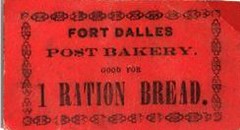 Last week I asked, "What is the fleeting connection of Dalles, OR with U.S. numismatics?". Here are our reader's responses.
-Editor
Last week I asked, "What is the fleeting connection of Dalles, OR with U.S. numismatics?". Here are our reader's responses.
-Editor
Phil Iversen writes:
It was supposed to become an Assay Office, but never came to fruition.
Joe Boling writes:
The Dalles had an almost-US branch mint - construction started, never finished, and authority withdrawn.
Ken Barr writes:
The formal name of the town is "The Dalles", Oregon. From Wikipedia, "The name of the city comes from the French word dalle (meaning either "sluice" or "flagstone" and referring to the columnar basalt rocks carved by the river."
And of course the numismatic connection is the never-quite-completed U. S. Mint authorized for construction in that city ... nice pictures and brief history at www.wasco-history.r9esd.k12.or.us/comm/td/mint.html
An E-Sylum readers writes:
The San Diego Numismatic Society enjoyed a lecture about this facility given by Jim Hunt, entitled "The Mint That Never Struck Coins," crediting an article written by SDNS member Paul Whitnah, at its March 2011 meeting.
From the club bulletin:
The Program for the March Meeting was given by Jim Hunt, based on an article by Paul Whitnah on "The Mint That Never Struck Coins." The Dalles Mint in Oregon was at the end of the Oregon Trail, and in 1849 The Dalles was a military outpost. Gold had been discovered in Oregon shortly before its discovery in California. Construction was started on a mint building, but it was never finished. The appointed Mint Director, Logan, was lost in the wreck of the Brother Jonathan. Although the building featured in several fires, in one of which the interior was destroyed, the building still stands.
John Mutch writes:
The Dalles, OR was intended to become a mint, but the facility just made it to the "assay office" stage. The local talk here in Boise at the time was that we should also have a mint, but, like The Dalles, we ended up with an assay office. Our Assay Office sits on a city block east of downtown and is in a great state of preservation. It is now owned by the Idaho Historical Society: history.idaho.gov/shpo-hours-location /
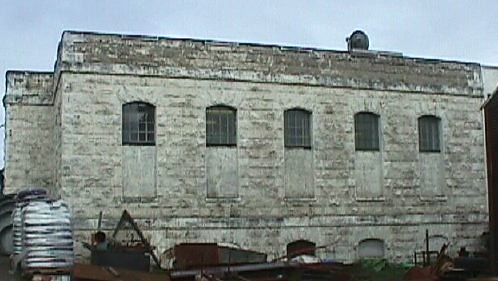
To read the earlier E-Sylum article, see: HOLABIRD-KAGIN AMERICANA WESTERN STATES TOKEN AUCTION MARCH 2012 (www.coinbooks.org/esylum_v15n13a16.html)
QUIZ ANSWER: THE HARTE-TWAIN NUMISMATIC CONNECTION
Joe Boling was the only reader to hazard a guess on my question about the numismatic location connecting authors Bret Harte and Mark Twain. He writes:
I'll take a WAG and say that Twain and Harte were likely to be found in Calaveras County.
Not correct, but good try. Mark Twain's story "The Celebrated Jumping Frog of Calaveras County" was published in 1865. It was based on a tale he'd heard while living in the gold fields of California.
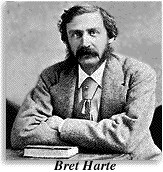 The numismatic connection has to do with Harte's day job - he was secretary to the Superintendent of the U.S. Mint in San Francisco. Samuel Clemens (a.k.a. Mark Twain) worked as a reporter for the San Francisco Morning Call, whose offices happened to be housed in the same building as the branch mint. In 1864 the newspaper's editor introduced Samuel Clemens to Harte, who "was the best-known of a group of young writers in San Francisco who often congregated at his Mint office."
The numismatic connection has to do with Harte's day job - he was secretary to the Superintendent of the U.S. Mint in San Francisco. Samuel Clemens (a.k.a. Mark Twain) worked as a reporter for the San Francisco Morning Call, whose offices happened to be housed in the same building as the branch mint. In 1864 the newspaper's editor introduced Samuel Clemens to Harte, who "was the best-known of a group of young writers in San Francisco who often congregated at his Mint office."
The quoted passage is from a book by James Edward Caron titled " Mark Twain: Unsanctified Newspaper Reporter". See the link below to read the page in Google Books: Mark Twain: Unsanctified Newspaper Reporter .
To read the earlier E-Sylum article, see: HOLABIRD-KAGIN AMERICANA WESTERN STATES TOKEN AUCTION MARCH 2012 (www.coinbooks.org/esylum_v15n13a16.html)
19TH CENTURY U.S. PORTRAIT IDENTIFICATIONS PROPOSED
Andrew W. Pollack writes:
Possibly Jacob Reese Eckfeldt?

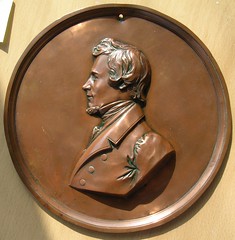
Gar Travis writes:
Looks like Jefferson Davis in a younger visage.
David Alexander writes:
Regarding Brother Eimer's electrotype, the facial features and the little chin beard strongly suggest a young Jefferson Davis, Senator and Secretary of War before the events at Fort Sumter led to his service as President of the Confederate States of America. Even if not Davis, the piece is a marvelous art work in any event.


To read the earlier E-Sylum article, see: QUERY: 19TH CENTURY U.S. PORTRAIT IDENTIFICATION SOUGHT (www.coinbooks.org/esylum_v15n13a10.html)
MORE ON THE SPANGENBERGER 1876 CENTENNIAL COLLECTION
Ron Abler writes:
As an aficionado of America's first World's Fair, the Centennial Exhibition, held in Philadelphia in 1876, I must take exception to Dick Johnson's statement that the first World's Fair was in Chicago in 1892-93. London's Crystal palace in 1851 is widely known as the first World's Fair, and the 1876 event as America's first World Fair.
To read the earlier E-Sylum article, see: MORE ON BRENNER AND EAGLE ENGRAVING & STAMPING (www.coinbooks.org/esylum_v15n13a08.html)
In response to Ron's earlier query, Joe Boling writes:
In regard to Hank Spangenberger's 1876 wood medals, a substantial collection of them was exhibited at the ANA's National Money Show in Ft Worth, earning first place in the History and Politics class and first runner up for best of show. The exhibitor was Robert Mayer.
The same collection, having changed hands and been reorganized, was again exhibited at the ANA World's Fair of Money in Chicago, where it received second place in the Medals, Orders, Decorations and Badges class. The exhibitor was Darrell Luedtke. I don't know if these were Hank's "medals," but it's the largest group of them I have seen.
To read the earlier E-Sylum article, see: QUERY: SPANGENBERGER 1876 CENTENNIAL COLLECTION SOUGHT (www.coinbooks.org/esylum_v15n13a11.html)
NOTES FROM E-SYLUM READERS: APRIL 1, 2012
Weinberg/Collins
Charlie Davis writes:
The Weinberg/Collins piece had absolutely no place in The E-Sylum. It is unfortunate that you chose to publish it.
German Artist W. Eberbach
Regarding Bob Mueller's mention of Walther Eherbach, David T. Alexander writes:
The German artist referred to in the stories about Paul Manship's "Kultur in Belgium" medal is properly W. Eberbach.
Tom DeLorey writes:
Does anyone know when in 1917 the Manship KULTUR medal was issued? It reminded me of the Thomas Elder piece I catalogued as DeLorey-97 with the legend:
"ONE RESULT OF/ PRUSSIAN KULTUR:/ 150 AMERICANS/ MURDERED/ ON THE HIGH SEAS!/ DOWN WITH THESE/ INTELLECTUAL/ BRUTES!"
These first appeared in the Elder sale of 6-29-17. The use of the term is probably coincidental, since it appears to refer to some naval atrocity (the Lusitania, perhaps?), but it is not inconceivable that Elder was inspired by the Manship piece.
To read the earlier E-Sylum article, see: MORE ON MANSHIP'S KULTUR IN BELGIUM MEDAL (www.coinbooks.org/esylum_v15n13a09.html)
Burglar's Bliss
Eric Schena writes:
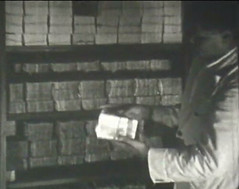 Here's a neat silent short film I blundered into from the mid 1930s showing a bank vault in an unspecified part of India chock full of money:
archive.org/details/BurglarsBliss
.
It's particularly interesting seeing all those high denomination George V notes considering how rare and expensive they are now.
Here's a neat silent short film I blundered into from the mid 1930s showing a bank vault in an unspecified part of India chock full of money:
archive.org/details/BurglarsBliss
.
It's particularly interesting seeing all those high denomination George V notes considering how rare and expensive they are now.
DAMIN Conference Proceedings Online
Regarding the recent Silver Monetary Depreciation and International Relations conference
(Dépréciation de l'Argent Monétaire et relations INternationales),
Georges Depeyrot writes:
Our conference at Paris last January is now completely available on internet at www.anr-damin.net . I guess it is the first time that a meeting is completely recorded.
Georges adds:
The second round table of the DAMIN program Silver Monetary Depreciation and International Relations will take place at Madrid, casa de Velazquez on 16-17 May 2013.
The general theme is "The transfers of precious metals and their consequences". Titles and abstracts are to be sent before December 31st, 2012. As for the Paris round-table, the presentations will be video recorded and available on the web site of the program. Proceedings will be published. Some grants are available. All the details on www.anr-damin.net .

Smithsonian Visitors Vote for the Cent
On the topic of the U.S. cent, Dick Doty, curator of the National Numismatic Collection at the Smithsonian writes:
When we built our new Numismatic display several years ago, we also wondered about the future of the cent, and we were curious about what members of the public thought about the matter: did they want to retain it or scrap it? We came up with a simple way of testing public opinion (besides making a bit of money for minor expenses). We put up a sign inviting people to vote Yes or No on the future of the cent. Below the sign were two holes, a receptacle beneath each hole. Dropping a cent or other coin in the "Yes" hole meant you wanted to keep the cent, while dropping one in the "No" hole meant that you wanted the denomination to go away.
We got some of the most amazing coins - to date, small-denomination pieces from nearly seventy countries, reflecting the varied nationalities of our visitors. But the most surprising thing was the vote itself: it's been running consistently in favor of keeping the denomination by a factor of nearly two to one! I can't explain why people want to retain a coin that does little more than annoy them - other than the fact that it's a piece of money, and there's something in each of us that says that you don't throw away money, even money as humble as this.
To read the earlier E-Sylum article, see: 10 REASONS WE NO LONGER NEED THE PENNY (www.coinbooks.org/esylum_v15n13a17.html)
The Loeb Classical Library
An email exchange about cross-checking the archived issues of The E-Sylum with a list inspired John Nebel to submit this photo of a recent book-sorting session of his:
When I downloaded the Loeb Classical Library index in spreadsheet form from the Harvard University Press web site and used it as a cross check, especially for alphabetizing books containing multiple authors' works or books alphabetized by translators name rather than the authors', I found a book not listed in the spreadsheet, Plautus volume V, and that duplicates of two others had been shipped.

a-x clockwise: P is the most common ancient author,
followed by A, then C For Latin, it's Cicero, then the others;
"Greek, Plutarch."
Sweden's Cashless Economy
Regarding Sweden's Cashless Economy, David Ganz writes:
This was certainly our experience. When Kathy & I took a cruise a few years ago from London to Stockholm via St Petersburg,, when we got to Stockholm I went to a newsstand near the Grand Hotel (where we stayed) to buy a newspaper after first changing some dollars for local currency, I needn't have. At the newsstand, someone bought a paper (in Swedish) and provided a credit card for the 50 cent purchase. Then another person did it, and another. They obviously have found a way to beat the minimum charges of Mastercard, Visa and American Express.

QUERY: CAMBODIAN COIN AUCTION CITATIONS SOUGHT
Howard A. Daniel III writes:
I came across ANS Numismatic Notes and Monograms No. 101, A Numismatic Bibliography of the Far East, by Howard Franklin Bowker in my library. Don't you think his first name has a nice ring to it? I remember his name being associated with East Asian numismatics but not my area of Southeast Asia. I started looking at the Subject Index and was happily surprised to find Cambodia, and other Southeast Asian countries.
I am into the last stages of my research for my next catalog, which will cover Cambodia from the 16th century to date. Bowker's Subject Index is for dealer's catalogues and has thirteen (13) for Cambodia. They are as follows;
C7. Bourgey, E., A. Salles Coll., Paris, July 1, 1929.
C9. Chapman, H., G.H. Earle Coll., Phila. June 25, 1912.
C12. Ciani, M.L., M. Chatillion, Paris, May 24, 1933.
C15. Elder, T., J.B. Wilson Coll., N.Y., Oct. 5, 1908.
C21. Frossard, E., N.Y., Nov, 25, 1882.
C25. Glendining and Co., London, May 27, 1936.
C28. Haseltine, J.W., S.W. Chubbuck Coll., N.Y., Feb 25, 1873.
C32. Low, L.H., W. Cutting Coll., N.Y., May 23, 1898.
C46. Schulman, J., V. Bergsoe Coll., Pt. 1., Amsterdam, April 14, 1903.
C50. ---------------, Lord Grantley Coll., Amsterdam, Dec. 12, 1921.
C54. ---------------, O. Leonardos Coll., Amsterdam, Jan 24, 1929.
C67. Stack's, N.Y., June 3 & 10, 1939.
C70. Weyl, A., Berlin, June 9, 1879.
If any readers have these catalogues in their library, please scan the lot description(s) and possible images, and email them to me at HADANIEL3@MSN.COM. If needed, I will pay for all costs.
QUERY: PORTRAIT VIGNETTES SOUGHT FOR FRACTIONAL CURRENCY BOOK
I'm helping work on a book related to U.S. fractional currency and I'm looking for some vignettes of some of the following people:
-
 Spencer M. Clark
Spencer M. Clark
- William H. Crawford
- Samuel Dexter
- William Fessenden
- Ulysses S. Grant
- George Washington
- William T. Sherman
- Francis Spinner
- Edwin Stanton
Also looking for individual vignettes of Meriwether Lewis & William Clark. I've attached a vignette of William Meredith which is of the style that I'm looking to find. I don't have any reference materials on vignettes so don't know if they even might exist.
QUERY: SCHULMAN MEDALLIC HISTORY OF MONEY AND BANKING
Web site visitor Holly Ponsell writes:
 I have a set of medals from Hans Schulman called the Medallic History of Money and Banking.
Can you tell me anything about them?
I have a set of medals from Hans Schulman called the Medallic History of Money and Banking.
Can you tell me anything about them?
I am really interested to know more about this set. It just seems neat to have the whole set complete and in such great condition. The letter from Hans Schulman claims that only 1,000 were made available. Not sure how true that ended up being since I have been told everyone was into creating medals during the 70's. Still it is from Hans Schulman and that's pretty neat to me.

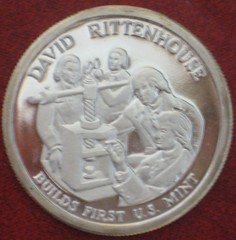
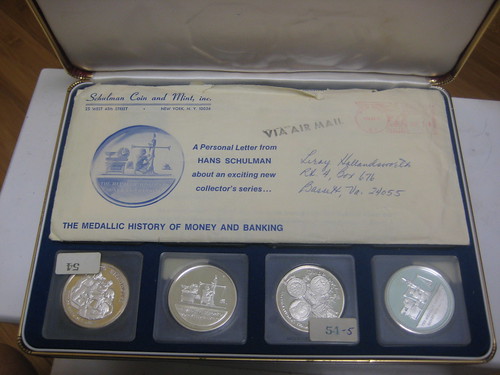
QUERY: LINCOLN MEDAL ORIGIN SOUGHT


Dick Doty, Curator of the National Numismatic Collection at the Smithsonian writes:
Sorry to ask for help, but The E-Sylum reaches more people with more backgrounds than anything else, and it seemed the best choice. Here are pictures of a medal we're trying to figure out. It's large, 82 mm, weighs 195 grams, is cast, die axis as you see it (in other words, the hand points up). We are trying to figure out who made it, more importantly when (I strongly doubt whether it dates from 1863, but maybe the 50th anniversary).
We're trying to put together a book of 150 iconic objects for the 150th anniversary of the war, and this one is under consideration, but ONLY if it can be reasonably pinned down to the years surrounding the event.

EXHIBIT: THE NEW MEDALLISTS
The V&A is one of my favorite museums, a highlight of my time in London in 2007. The self-titled "world's greatest museum of art and design" is exactly that, and more. Where better to showcase medallic design? -Editor
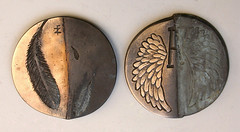 Natasha Ratcliffe, Petra Mills, Sara Richards, Chloe Shaw, Phoebe Stannard and Heidi Hinder are the New Medallists. Their work breathes new life into the centuries-old art of the medal. Usually cast in metal, art medals are small sculptures, made for personal pleasure or contemplation. Often deeply introspective, these objects are best appreciated in the hand, where they may connect intimately with their (be)holder.
Natasha Ratcliffe, Petra Mills, Sara Richards, Chloe Shaw, Phoebe Stannard and Heidi Hinder are the New Medallists. Their work breathes new life into the centuries-old art of the medal. Usually cast in metal, art medals are small sculptures, made for personal pleasure or contemplation. Often deeply introspective, these objects are best appreciated in the hand, where they may connect intimately with their (be)holder.
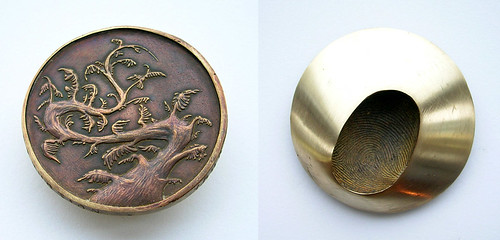
In this display, the New Medallists tell us the thoughts behind the medals they created and how works by their mentors and objects from the V&A collections have inspired their practice. The display celebrates the first six years of the New Medallist scheme, an initiative run by the British Art Medal Society (BAMS) in association with the V&A, the British Museum and the Royal Mint and supported by the E.S.G. Robinson Trust. By nurturing a new generation of British medallists, the New Medallist scheme is designed to stimulate the field's originality. In making a contribution to the present, the New Medallists will shape the future of medals in Britain and Ireland.
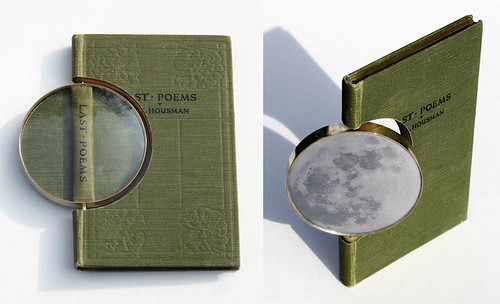
To read the complete article, see: The New Medallists (www.vam.ac.uk/content/articles/t/the-new-medallists/)
FRELINGHUYSEN STAMP COLLECTION BRINGS RARITIES TO MARKET
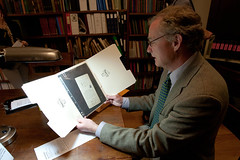 Many families have some treasures in the attic. Fred Frelinghuysen knew he had something, too, but he realized its significance only when the time came to let it go.
Many families have some treasures in the attic. Fred Frelinghuysen knew he had something, too, but he realized its significance only when the time came to let it go.
The Frelinghuysens are among New Jersey's oldest and most distinguished political families, with roots stretching to 1720 and a roster in public service that includes senators, congressmen, a vice presidential candidate and a secretary of state. Schools, streets, a township and even an arboretum are named after them.
There is also, until recently unknown to any but a few family members, a Frelinghuysen stamp collection. It is not your uncle Pete's schoolboy album replete with five-and-dime commemoratives, but a large and expertly curated holding, put together by Peter H. B. Frelinghuysen Jr., a former congressman who died last year at age 95, that includes rarities from the earliest days of American postal history.
Now Peter Frelinghuysen's five children, including Fred and his brother Rodney, who is serving his ninth term representing New Jersey's 11th Congressional district, are putting the collection under the hammer in a two-day auction that began Wednesday in Manhattan.
"It was a passion for him for many years," said Fred Frelinghuysen, 58, discussing the difficult decision to sell his father's stamps in order to settle his estate. "We were always aware of the collection. It was something we would bring out when we were on vacation or had time to relax."
Among the show-stoppers are stamps like the Inverted Jenny, the iconic first American airmail stamp of 1918, on which a little blue biplane, nicknamed Jenny, was printed upside-down by mistake. Just 100 of those exist, and every year a couple of them come up for auction someplace, typically selling for six figures.
Except for Frelinghuysen's. His specimen, to be offered Thursday, has been up for auction only once in the nearly 100 years since it was discovered. At that sale, in 1932, a certain Mrs. F. - young Peter's mother - bought it for her son, paying $2,750. The seller was Peter's second cousin, Joseph S. Frelinghuysen Sr., a former United States senator.
According to Scott Trepel, the head of Robert A. Siegel Auction Galleries, which is selling the collection, the Frelinghuysens hold the record for an Inverted Jenny stamp owned for the longest time by one family.
"The emergence of the Frelinghuysen collection answers many questions about the whereabouts of important philatelic rarities, which were known from old photographs, but had seemingly vanished," Mr. Trepel, wrote in the sale catalog. The book includes a wealth of historical information about the stamps' origins, much of it collected in one place for the first time.
Many of these provisional stamps are crudely designed and printed. They are also exceedingly rare, some surviving in only a handful of examples. The total for the 95 lots sold Wednesday was $2.96 million, including the 15 percent buyers' premium.
Many of the United States stamps from the collection being offered Thursday were also salted away for decades. Some items previously thought to be "probably unique," according to the catalog description, now turn out to have long-lost twins, including a block of four three-cent stamps from 1867 with a marginal imprint reading "National Bank Note Co. New York."
To read the complete article, see:
A Stamp Collection With Rare Delights Leaves a Family's Holdings for Auction
(www.nytimes.com/2012/03/29/nyregion/frelinghuysen-familys-rare
-stamp-collection-goes-to-auction.html)
FERN BAR FOUNDER'S ORIGINAL TIFFANY LAMPS BEING SOLD
The original Tiffany lamps that lined the bar at Eddie Rickenbacker's pub in San Francisco are heading to a New York City auction house, where they are expected to bring more than $2 million, Christie's said Thursday. All six of the table lamps and one Tiffany hanging chandelier will hit the auction block on June 14.
Eddie Rickenbacker's colorful proprietor, Norman Jay Hobday, died in February 2011. He is credited with inventing the "lemon drop" martini and the "fern bar," a term applied to another bar he had owned called Henry Africa because of all the hanging plants. Hobday later adopted Henry Africa as his own name.
His signature decor at Eddie Rickenbacker's included vintage motorcycles hanging from the ceiling and the Tiffany lamps. He purchased his first Tiffany lamp at a 1993 auction, and kept them safe using "a low-tech security system," said Josh Holdeman, Christie's director of 20th century art, who met the bar owner in 2004. "They were intertwined with all the high balls and low balls and the martini glasses and they were secured by a chain around which each had a padlock," he said.
"He was a very eccentric, colorful character," who loved how the lamps made the bar light up with all the vibrant colors that came through the glass, Holdeman said. "He just felt they really made the entire place seem totally alive."
To read the complete article, see: Eddie Rickenbacker's pub in San Francisco Tiffany lamps coming to New York City auction (www.artdaily.org/index.asp?int_sec=2&int_new=54470)
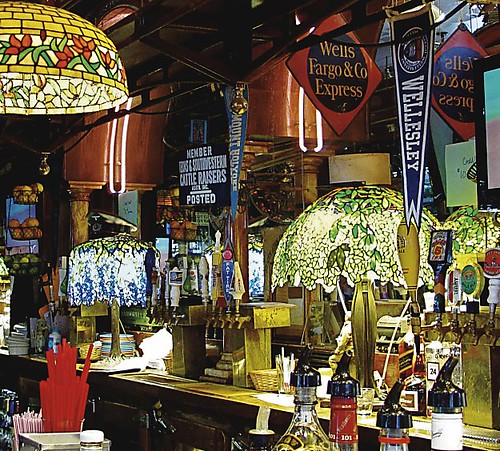
To read the complete article, see: Tiffany lamps from SF pub head to auction (www.sfgate.com/cgi-bin/article.cgi?f=/c/a/2012/03/29/BA2I1NS6QB.DTL)
ARTICLE HIGHLIGHTS PHOENIX "PHX BUX" COINS
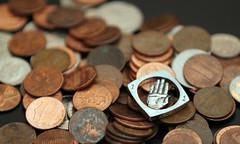 It was a comfortably warm day in downtown Phoenix as Crystal Botella sat on Jobot Coffee Shop's patio and drank from a can of root beer with a straw stuck in it.
It was a comfortably warm day in downtown Phoenix as Crystal Botella sat on Jobot Coffee Shop's patio and drank from a can of root beer with a straw stuck in it.
The Arizona native was dressed in a colorful sundress, with earrings made out of "Phx Bux" coins dangling from her ears.
Botella's designs favor metals, and Phx Bux, silver metal coins with an open hand in the middle, are seen in many of her creations.
"They are a part of Phoenix history," Botella said.
Phx Bux are now a rare commodity in Phoenix since they went out of circulation a few years ago. Botella has roughly 100 left.
The coins were local currency that business partners Joey Grether and John Sagasta launched in summer 2009. The currency was accepted by at least 25 Phoenix businesses.
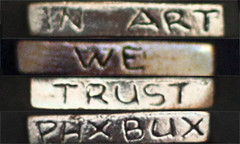 Participating businesses paid $1 per coin and pledged to accept Phx Bux in addition to traditional forms of payment. Customers could request their change in Phx Bux and take coins to other stores that accepted Phx Bux, where the coins were worth $1. The majority of shops allowed only one coin per purchase.
Participating businesses paid $1 per coin and pledged to accept Phx Bux in addition to traditional forms of payment. Customers could request their change in Phx Bux and take coins to other stores that accepted Phx Bux, where the coins were worth $1. The majority of shops allowed only one coin per purchase.
Grether created Phx Bux to challenge Phoenicians to rethink local currency and who is actually controlling their money.
Layal Rabat, who is frequently downtown, enjoyed using the local currency but said that once the coins were in circulation, people started hoarding or creating art with them.
"I think that if someone thought to trade (Phx Bux) for services or necessities, they would have lasted a lot longer," Rabat said. "They mostly worked like coupons. I used them for coffee but don't recall buying art with them."
Chadwick Uptain, a local artist, carved the original Phx Bux design and created the molds with the help of a former business partner. They created 3,500 coins.
Uptain still has the original sterling silver casting used to make the molds. Grether now owns many of the coins, sharing them occasionally, and has the original $2 design.
"The Phx Bux had the potential to be huge," Uptain said. "I think it failed because the creators, John and Joey, began to realize that in order to maintain and grow such an ambitious project it was going to require a lot of work and money."
Uptain wanted to create multiple coin denominations to generate revenue for advertising, marketing and networking but realized Grether was uncomfortable with the idea of making a profit or the risk of legal consequences.
"We were using it more like a coupon than currency, but if the feds decided to call it counterfeiting, there could have been trouble," Uptain added.
Phx Bux have become a novelty item and are being collected by many people who appreciate the coins' uniqueness and history.
To read the complete article, see: Out of circulation, 'Phx Bux' coins become novelty items for downtown collectors (downtowndevil.com/2012/03/28/24944/phx-bux-coins-become-novelty-collectors/)
THE BOOK BAZARRE
CANADA TO ELIMINATE THE CENT
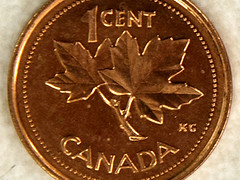 It's the end of the line for Canada's humble penny.
It's the end of the line for Canada's humble penny.
The government has decided our lowest denomination coin is more trouble than it's worth, so the Royal Canadian Mint will stop distributing the penny this fall.
"It's a currency without currency," Finance Minister Jim Flaherty said Thursday.
In his budget speech, he said the only surprise is that the penny survived for so long.
"Pennies take up too much space on our dressers at home. They take up far too much time for small businesses trying to grow and create jobs," he said in prepared remarks.
"It costs taxpayers a penny-and-a-half every time we make one. We will, therefore, stop making them."
Cash transactions will soon be rounded to the nearest five-cent increment. So if a coffee costs $1.27, it will be rounded down to $1.25. If it's $1.28, the final cost will be bumped up to $1.30.
Round down: cash transactions that end in one, two, six or seven cents.
Round up: Cash transactions that end in three, four, eight or nine cents.
All cash transactions will be rounded on the final bill of sale, after taxes have been added. But transactions involving debit or credit cards, or cheques, will still be done to the cent.
So if you pay for that $1.27 coffee with a debit card, it won't be rounded to the nearest nickel.
To read the complete article, see:
Gov't scraps penny, a 'currency without currency'
(www.ctvbc.ctv.ca/servlet/an/local/CTVNews/20120329/
budget-spending-cuts-pennies-120329/20120329?hub=BritishColumbiaHome)
Here's another article:
Now the Canadian penny's days are numbered, is the nickel next?
(news.nationalpost.com/2012/03/29/now-the-canadian-pennys
-days-are-numbered-is-the-nickel-next/)
DICK JOHNSON: CANADA ABOLISHES CENT
Pull out the 72-point boldface type for this headline: CANADA ABOLISHES CENT.
Subhead: Production of Money Losing Coin To Cease This April; Tally Prices To Be Rounded Off To Nearest 5 Cents
The press -- both print and broadcast -- has responded vociferously, on both sides of the border. Most report Canadian officials in their bold decision for the monetary move. It culminates four years of study in Canada. It is estimated to save $11 million in minting costs alone. Not having to stock, store and distribute cents in making change will save Canadian retail and banking establishments untold millions more.
The last cent coin will be struck this month, April 2012. The Royal Mint will continue to distribute its stock of the coins on hand. It should run out by Fall. There are between 30 and 35 billion Canadian cents in circulation. They will not be demonetized -- they will continue to "circulate" until no longer viable, whenever that may be
Here are some of those press comments in the last three days. Expect more.
Business Week: Repeated a Canadian government statement which said "New Zealand, Australia, the Netherlands, Norway, Finland, Sweden and others 'have made smooth transitions to a penny-free economy.' It said penny production cost $11 million a year, and that the coins, which feature two maple leaves and Queen Elizabeth II in profile, would remain legal tender until they eventually disappeared from circulation."
CNET News: "Desjardins Group has estimated that the coin costs businesses $150 million a year in counting and transport costs. Meanwhile, it costs a penny and a half to mint every penny, and cutting it will save $11 million annually, according to the Department of Finance. At least Canada is only losing on its pennies -- the Mint says other Canadian coins cost 'well under face value' to produce. It thumbed its nose at the U.S.: "Not so south of the border. It costs the United States Mint 2.41 cents to produce every cent and 11.18 cents for every nickel. In the year to September 30, 2011, that resulted in a loss of $116.7 million, according to Coin Update, a site devoted to coin news."
news.coinupdate.com/cost-to-make-penny-and-nickel-rises-1139/
Forbes quoted Stephen J. Dubner of Freakonomics asks, "Canada Kills Its Penny; Can We Please Be Next?" Not so fast, said an advocacy group, Americans for Common Cents (www.pennies.org), which worries about the alternative to pennies in cash transactions - merchants rounding up, not down. In a survey released this week, the group found that two-thirds of adults polled favored keeping the penny in circulation. [That's obsolete data, public opinion has now swung in favor of abolishment.]
www.freakonomics.com/2012/03/30/canada-kills-its-
penny-can-we-please-be-next/
finance.yahoo.com/news/americans-common-cents-66-americans-215000691.html
Canada Daily News quotes a coin collector and dealer, Chris Linfitt, president of the Mid-Island Coin Club and owner of Nanaimo's West Coast Stamp & Coin, said a penny just doesn't buy anything anymore so "it's about time" that the coin will be discontinued. Further he said he expects it will be a long time before Canadian pennies will be worth anything as collectable coins.
CoinWeek in contrast stated: I suspect that Canadians will start hoarding their cents soon in the hope that they will be worth a premium after they are no longer available in circulation. This is what European Union citizens did during the transition to the euro currency. According to Canadian officials, 17 other countries have already done away with their lowest denomination coin.
Calgary Herald: One of Calgary's most astute business minds, W. Brett Wilson, has also been saying that it's time to punt the penny. After all, the government's move to take the penny out of circulation this fall will save the Canadian economy about $11 million a year.
Duluth News Tribune believes the coins will become collectible. It editorialized: So the next time some sly Northland cashier slips Queen Elizabeth and her maple leaves in with your Abe Lincolns, don't fret. You'll have a future collector's item in the palm of your hand.
Reuters reports: "Some Canadians consider the penny more of a nuisance than a useful coin. We often store them in jars, throw them away in water fountains or refuse them as change," the government said in a budget document. Financial institutions face increasing costs for handling, storing and transporting pennies. Over time, the penny's burden to the economy has grown relative to its value as a means of payment," it said.
San Francisco Chronicle: "Saving pennies in a piggy bank may be fun for children, but for banks, the transportation, handling and storage of coins costs about C$20 million each year according to Canadian officials, a cost that has to be passed on to customers in the form of fees. Eliminating the penny saves a portion of the costs associated with processing coins. Some argue that cash registers will have to be reprogrammed to accommodate the switch, but since the penny will remain in circulation until most pennies are out of circulation and taxes will continue to be calculated to the penny, cash registers and other business machines will operate as they always have."
www.investopedia.com/articles/07/banking.asp?
partner=sfgate#axzz1qq9cd0N1
Time Moneyland: "In April, Canada will mint its final penny, and a few months later, it will halt all distribution of pennies to the country's financial institutions as it attempts to withdraw them from circulation. As for how Canadian businesses and consumers deal with a world without pennies, that's largely up to them. The government is suggesting that they either round up or down to the nearest five cents. For those who use debit or credit cards, prices will still be charged to the cent. Still, many businesses will have to deal with logistical issues like reprogramming cash registers and changing their pricing." The Canadian government says it loses $11 million each year making and distributing pennies, and the cuts are part of a larger package of reductions estimated at $5.2 billion.
Read more:
moneyland.time.com/2012/03/30/canadas-penny-is-no-more
-is-the-u-s-penny-next/#ixzz1qp3tcld8
A REVIVED EAST INDIA COMPANY STRIKES COINS
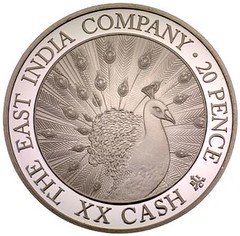

Over three hundred years after The East India Company was first given the right to mint its own currency by Charles II in 1677, the company has announced the issue of its legal tender coins returning to its by-gone days in the bullion trade. The Limited Edition gold proof coins are struck by the Royal Mint, who first minted coins for The East India Company over two hundred years ago.
The coin designs are inspired by the main trading currencies The East India Company used in the 17th - 19th century ─ CASH and Mohur. The silver 'CASH' proof coins features a peacock design symbolizing immortality and rebirth and are available in a 1/2oz and 1oz coin equivalent to a 10p and 20p respectively. The gold Mohur proof coins bear the famous Lion & Palm Tree motif denoting wealth and prosperity and are available in a half and one Mohur coin equivalent to 50p and £1 respectively
Commenting on the launch of their legal tender coins Sanjiv Mehta, Managing Director and Chairman of The East India Company, said: "The East India Company is proud to present its first silver and gold coins. The company has been known in the precious metal trade since 1800. It was and still is the only corporate in history to mint its own trading currency. It made sense to commission our own silver and gold coins in this day and age. The precious metal trade formed an important part of The East India Company's trading activities and we plan to re-establish this position for the company today."
To read the complete article, see:
The East India Company Issues its First Legal Tender Coins Since 1874
(www.coinweek.com/news/modern-coins/world-mint-news/
the-east-india-company-issues-its-first-legal-tender-coins-since-1874/)
From the company web site:
Initially East India Company coins were minted in England and shipped to the East. In England over time the word 'Cash' was adopted from the Tamil word "Kasu", meaning 'a coin'. East India Company coinage had both Urdu and English writing on it, to facilitate its use within trade. In 1671 the directors of The East India Company ordered a mint to be established at Bombay, known as Bombain. In 1677 this was sanctioned by The Crown, the coins, having received royal sanction were struck as silver Rupees; the inscription runs The Rupee of Bombaim, by authority of Charles II.
At about this time coins were also being produced for The East India Company at the Madras mint. The currency at The Company's Bombay and Bengal administrative regions was The Rupee. At Madras, however, The Company's accounts were reckoned in "Pagodas", "Fractions", "Fanam", "Faluce" and "Cash". This system was maintained until 1818 when the Rupee was adopted as the unit of currency for The Company's operations, the relation between the two systems being 1 Pagoda equaling 3-91 Rupees and 1 Rupee equaling 12 Fanams.
Over time, coins of The East India Company achieved an almost universal circulation in India. The use of a national single value of Cash facilitated internal trade between the regions, laying foundations for a national commercial system.
To visit the company web site, see: www.theeastindiacompany.com
FAMILY HOLDS RECORD FOR VICTORIA CROSS AWARDS
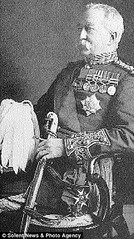 A family has been named the most courageous in Britain after being awarded a record breaking three Victoria Cross Medals for acts of bravery in battle.
A family has been named the most courageous in Britain after being awarded a record breaking three Victoria Cross Medals for acts of bravery in battle.
In just two generations of the Gough family, three male members were awarded the VCs for acts of 'extreme gallantry and devotion to duty in the face of the enemy'.
The heroic exploits of the Gough family are detailed in a new guide, which lists all 1,353 recipients of the country's highest military honour for the first time.
The online database, by family history website ancestry.co.uk, contains a detailed description of their heroic acts and where they are buried.
It also includes photographs of every recipient, their gravesite and their medal - from the first in 1857 to the last in 2007.
General Sir Charles Gough was the first in his family to be awarded the VC for numerous acts of bravery from the age of 25.
To read the complete article, see: Meet the Goughs: The extraordinary family who were awarded a record-breaking THREE Victoria Cross Medals in just two generations (www.dailymail.co.uk/news/article-2121419/Britains-bravest-family-awarded-record-breaking-Victoria-Cross-Medals-just-generations.html)
FEATURED WEB SITE: THE BRITISH ART MEDAL SOCIETY
This week's Featured Web Site is the British Art Medal Society.The British Art Medal Society has commissioned medals from many distinguished contemporary sculptors. Their work is extremely varied. There is portraiture and abstraction, the neo-classical, the conceptual and the satirical. Some are struck from hand engraved dies, the majority are cast in bronze and patinated by the artist.
On our website you have the opportunity to browse through the gallery of medals. Some medals are for sale as limited editions, and we also have a selection of books in our shop. You can subscribe to our magazine, 'The Medal' and find details of membership, whether as a contributing artist or interested viewer.
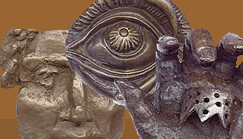
www.bams.org.uk
